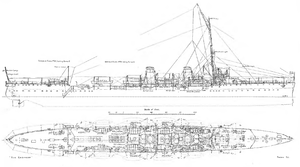|
Bahia-class cruiser
The Bahia class was a pair of scout cruisers built for Brazil by Armstrong Whitworth in the United Kingdom, based on a design that borrowed heavily from the British Adventure-class scout cruisers. The class comprised the lead ship Bahia and her sister Rio Grande do Sul, along with a canceled third ship, Ceara.[4] Both were named after states of Brazil. As a class, they were the fastest cruisers in the world when commissioned, and the first in the Brazilian Navy to use steam turbines for propulsion. In the mid-1920s, both ships were extensively modernized with three new Brown–Curtis turbine engines and six new Thornycroft boilers, and, in the process, was converted from coal-burning ships to oil-burning. The refit resulted in a striking aesthetic change, with the exhaust being trunked into three funnels, instead of two. The armament was also modified; three 20.1 mm (0.79 in) Madsen guns, a 7 mm (0.28 in) Hotchkiss machine gun, and four 533 mm (21.0 in) torpedo tubes were added. In the Second World War, both were used as convoy escorts. On 4 July 1945, Bahia was lost after an accident caused a massive explosion which incapacitated the ship and sunk her within minutes, resulting a large loss of life. Rio Grande do Sul survived the war and was scrapped in 1948. DesignThe class's design borrowed heavily from the British Adventure-class scout cruisers.[1] The ships displaced 3,100 tonnes (3,100 long tons),[1][2] and their dimensions were 122.38 m (401 ft 6 in) overall, 115.82 m (380 ft 0 in) between perpendiculars, 11.89–11.91 m (39 ft 0 in – 39 ft 1 in) at the beam, and a draft of 3.81 m (12 ft 6 in) forward, 4.75 m (15 ft 7 in) amidships, and 4.42 m (14 ft 6 in) aft.[2] They were powered by five Parsons steam turbines, and ten Yarrow boilers, with a coal bunker that could hold a normal load of 150 t (150 long tons), and a maximum load of 650 t (640 long tons).[3] The Bahia class was designed to reach a speed of 26.5 knots (49.1 km/h; 30.5 mph);[2] both ships exceeded this during trials with Bahia reaching 27.016 knots (50.034 km/h) at trial.[1] As designed, the class's range was 1,400 nautical miles (2,600 km; 1,600 mi) at 23.5 knots (43.5 km/h; 27.0 mph), or 3,500 nautical miles (6,500 km; 4,000 mi) at 10 knots (19 km/h; 12 mph).[3] The class was armed with ten 120 mm (4.7 in)/50 caliber, six QF 3 pounder 47 mm (1.9 in)/50 caliber guns[1][2] and two 457 mm (18.0 in) torpedo tubes.[1] The class was lightly armored with only 19 mm (0.75 in) of deck armor, with the conning tower having 76 mm (3.0 in).[1] Vickers would later pitch the Bahia design to the Ottoman Navy in 1912, but nothing came of it prior to the outbreak of the First World War.[5] ConstructionThe class was part of a large 1904 naval building program by Brazil.[6][7] Also planned as part of this were the two Minas Geraes-class dreadnoughts, ten Pará-class destroyers, three submarines and a submarine tender.[7][8] With a design that borrowed heavily from the British Adventure-class scout cruisers,[1] Bahia's keel was laid first on 19 August 1907 in Armstrong Whitworth's Elswick, Newcastle upon Tyne yard, followed by Rio Grande do Sul 30 August 1907.[1][9] Construction took about a year and a half, and both ships were launched in 1909.[6][9][A] Both ships were completed and commissioned into the navy in 1910.[2] As a class, Bahia and Rio Grande do Sul were the fastest cruisers in the world when they were commissioned,[1] and the first in the Brazilian Navy to utilize steam turbines for propulsion.[2] ModernizationBahia prior to being modernized between 1925 and 26, with a low bridge and two funnels. Bahia post-modernization. The most striking visual changes were adding height to and adding a third funnel. Even though oil has a greater thermal efficiency, an extra funnel was necessitated by the arrangement of new oil-firing boilers, where two each were placed in three independent compartments.[10] In the mid-1920s,[1][2][6][B] the class underwent significant modernization.[2] The original five turbines were replaced by three Brown–Curtiss turbines, while the original ten boilers were replaced by six Thornycroft oil-burning boilers, which necessitated the addition of a third funnel. The former coal bunkers, along with some of the space freed up by the decrease in boilers, were converted to hold 588,120 L (155,360 US gal) of oil.[2] These changes resulted in Bahia's top speed increasing to 28 knots (52 km/h; 32 mph).[1] All of the boats on board were replaced, and three 20.1 mm (0.79 in) Madsen guns, a 7 mm (0.28 in) Hotchkiss machine gun, and four 533 mm (21.0 in) torpedo tubes were added to give the ship a defense against aircraft and more power against surface ships.[2] The class was modernized again twice during the Second World War, in both 1942 and 1944. The modernizations were not as extensively as it was in the 1920s; the Brazilian Navy's official history of Bahia reports these but does not specify what modifications the ship underwent in which year.[2] Two 47 mm (1.9 in) guns were replaced with 76 mm (3.0 in) L/23 AA guns, Madsen guns were replaced with seven Oerlikon 20 mm cannons in single mounts, and a director for these guns was installed.[2] Two depth charge tracks were added, improved range-finders were added to the 120 mm (4.7 in) guns, and sonar and radar were fitted, in addition to other minor modifications.[2][C] Loss of the BahiaOn 4 July 1945, Bahia was acting as a plane guard for transport aircraft flying from the Atlantic to Pacific theaters of war. While Bahia's gunners were firing at a kite for anti-aircraft practice, one fired too low and hit depth charges stored near the stern of the ship. A massive explosion incapacitated the ship and sank her within minutes, resulting a large loss of life.[1][11][12] Notes
Footnotes
References
|
||||||||||||||||||||||||||||||||||||||||||||||||


